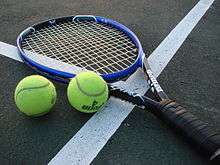Electronic line judge

An electronic line judge is a device used in tennis to automatically detect where a ball has landed on the court. Attempts to revolutionize tennis officiating and the judging of calls in the sport began in the early 1970s and has resulted in the design, development and prototyping of several computerized, electronic line-judge devices. The methods have been based upon the use of pressure sensors, sensors to detect magnetized or electrically conductive tennis balls, infrared laser beams, and most recently video cameras.
Development
The first successful public demonstration of a computerized device to make automated line calls at a professional tennis tournament was in 1974. (The Electroline-control computer pictured at the right). This original tennis electronic line judge device, invented by Geoffrey Grant, an avid tennis player, and Robert Nicks, an electronics engineer, was used in the championship finals of both the Men’s World Championship Tennis in Dallas in May, 1974 and the Ladies’ Virginia Slims tour in Los Angeles.[1][2] Although the Grant-Nicks pressure sensor based system was given rave reviews in the press at its introduction[3] and was issued with a USPTO patent,[4] the product was never commercialized.

This inaugural electronic line-judge device worked on a principle of large, thin mylar conductive plastic pressure sensors beneath the surface of a carpet court. It was able to distinguish between a foot and the tennis ball; the computer detected the sharp, millisecond pulse of the ball bounce striking the ground, as compared to the slowness and electronic print of player’s foot movements. Even when a foot was present on the sensor a dynamic load circuit was able to detect and distinguish between the signals. Beneath the court surface on each boundary line of the court were both and "in" and "out" sensors so that if a ball hit the outside of the line and also hit the "out" sensor the computer would correctly overrule the "out" call allowing play to continue.
This first electronic device made decisions not only as to whether the ball landed within the boundaries of the playing zones, but also was wired to make foot fault and service net-cord legal serve decisions. The foot fault judge used directional microphones to detect the striking of the ball by the player’s racquet, when serving the ball, that functioned in conjunction with a timing circuit to detect if the players foot had activated the baseline line ‘IN’ sensor immediately prior to, or during, the striking of the ball. The net cord ‘Let’ sensor was a simple piezoelectric device, initially a guitar pickup, to detect if the tennis ball touched the net during the service delivery. The service line sensors, net-cord sensor, legal serve and foot fault devices were turned "on" in unison during the process of a player serving the ball at the beginning of each point and then turned "off" as the opponent returned the ball.
In its successful inaugural use, at the Men’s World Championships of Tennis 1974 finals in the Southern Methodist University indoor stadium in Dallas TX, the device was limited to judging only the service line. A later prototype was used to call all tennis court lines plus the net-cord as at the Ladies Virginia Slims championships in Los Angeles during 1975.
The second system that was publicly demonstrated to electronically officiate line calls was introduced in Edinburgh, Scotland, UK at the Pernod sponsored tennis event in July 1977.[5] pdf file. The system was invented by Lyle David,(pdf file) who patented electrically conductive tennis balls, a micro-computer network systems equipment and installed wires at the boundaries of the court to detect and determine the location of the contact of the ball with the surface.[6]
The system had some failings with respect to reliability and, like the Grant-Nicks pressure sensor device, did not emerge as a commercial product.
Commercially, the most successful system to emerge in the early experimental period of electronic officiating was the "Cyclops". Cyclops was a device used only for service line calls but functioned reliably and was used around the world for many years until superseded by video and television technology. The Cyclops system consisted of a series of infrared laser light beams projected, at a centimeter above the ground, to a receiver device across the court and then to a computer. The series of beams were aligned to accurately determine if the ball was inside the service area. This determination was only valid with respect to the main service line and not the side or center service lines. The Cyclops system was used only on show courts and covered only the main service lines.
In the 2000s, the sport began to embrace video camera methodology such as Hawk-Eye.
Hawk-Eye allows review of player questioned line calls on a select few ‘high’ visibility televised matches. This limited use has been criticized as a social discontinuity in that players of lesser stature that are not asked to play on show courts are being unfairly discriminated against.
The professional tennis players associations, both the Association of Tennis Professionals and the Women's Tennis Association have approved a method and process of instantaneous re-evaluation of questionable line calls and the system of television video review has become popular.
See also
References
- ↑ Electronic Design Magazine 9 April 26, 1976, p55-57. An electronic linesman decides where the tennis ball bounces. By John F. Mason pdf file
- ↑ Tennis Magazine January 1975, p20-22. Is the tennis lineman obsolete? by Ken Bentley. pdf file
- ↑ "Electroline Newspaper Articles". Geoffreygrant.com. Retrieved 2011-07-19.
- ↑ "# 3,982,759". Google.com. Retrieved 2011-07-19.
- ↑ The (LONDON) Times-Online July 26, 1977. By Rex Bellamy.’Electronic Linesman to aid rectitude’.
- ↑ USPTO patents # 4071242. # 443258 and # 4855711.
